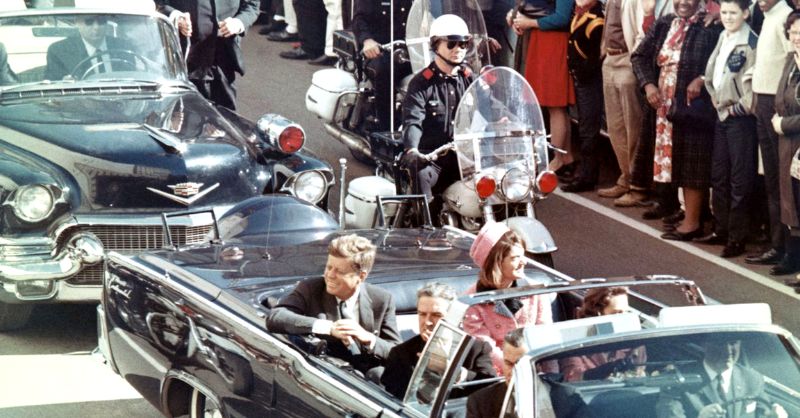
Image credit: Wikipedia
President Donald Trump has issued an executive order directing the declassification of government records related to the assassinations of President John F. Kennedy (JFK), Senator Robert F. Kennedy (RFK), and Reverend Dr. Martin Luther King Jr. (MLK).
This historic action comes after decades of public fascination, conspiracy theories, and limited transparency. Signed on January 23, 2025, the executive order reflects Trump’s promise to provide transparency to the American people and the families of these prominent figures. “Their families and the American people deserve transparency and truth,” Trump stated.
Just a while back, we also wrote about, what Trump did to Equal Employment Opportunity Act of 1972. It’s an interesting read too.
The executive order
The executive order requires the Director of National Intelligence (DNI) and the Attorney General to create plans for the release of the records:
- Full release of JFK assassination records within 15 days.
- Full release of RFK and MLK assassination records within 45 days.
Trump emphasized that withholding these records is “not in the public interest and is long overdue.” He assured the public that “everything will be revealed.”
Historical context: The JFK assassination
President John F. Kennedy was assassinated on November 22, 1963, in Dallas, Texas. Lee Harvey Oswald, a former Marine, was identified as the assassin. The Warren Commission concluded that Oswald acted alone, but his subsequent murder by nightclub owner Jack Ruby only two days later fueled widespread speculation and conspiracy theories.
In 1992, the JFK Assassination Records Collection Act mandated the release of all related documents within 25 years, allowing postponement only if national security or other significant interests outweighed the public interest. Over 5 million records related to the JFK assassination are held by the National Archives and Records Administration (NARA).
Previous declassification efforts
Trump’s order builds upon prior efforts:
- In 2017, President Trump authorized the release of approximately 2,800 JFK documents.
- In 2018, another 19,000 documents were released, though some were delayed for national security reasons.
- In subsequent years, Presidents Joe Biden and Trump himself delayed additional disclosures. Notably, in 2022, President Biden released 13,173 documents, but others remained redacted or unreleased.
Currently, 97% of JFK records in the National Archives are public. However, thousands of documents remain withheld, fueling ongoing intrigue.
The remaining documents
According to researcher Jefferson Morley, approximately 3,600 JFK-related documents have partial or significant redactions. Around 3,000 records remain unreleased entirely, many of which originated with the CIA. Certain documents, such as tax returns, were exempt from disclosure requirements under the 1992 act, while others have been destroyed over time. Records outside NARA, held by agencies like the CIA and FBI or even the Kennedy family, may also fall under the scope of Trump’s executive order.
Conspiracy theories and public interest
The redaction and withholding of documents have long fueled conspiracy theories surrounding the assassinations. Common theories include:
- Lee Harvey Oswald colluded with another gunman.
- Oswald acted under orders from the Soviet Union or another foreign power.
- U.S. officials, including CIA operatives, were involved in the assassination plot.
Robert F. Kennedy Jr., nephew of JFK, has publicly expressed his belief that the CIA was involved in his uncle’s assassination. Historian Larry J. Sabato noted that while the release of records may not reveal a definitive “smoking gun,” it could provide critical context and insights into the events.
Records related to RFK and MLK
The records concerning the assassinations of RFK and MLK are not as centralized or extensively cataloged as those of JFK, making their full release more challenging.
- Senator Robert F. Kennedy was assassinated in 1968 by Sirhan Sirhan, reportedly motivated by RFK’s support for Israel.
- Reverend Martin Luther King Jr. was assassinated in Memphis, Tennessee, the same year. James Earl Ray, who initially confessed to the crime, later recanted his confession and claimed innocence.
The FBI’s surveillance of King, including wiretaps and informant reports, adds another layer of complexity to the release of these documents.
The declassification process
Under Trump’s order, the DNI and Attorney General must present plans for declassification within 15 days for JFK records and 45 days for RFK and MLK records. Intelligence agencies are expected to review the documents for potential national security concerns, potentially leading to further delays.
NSA involvement
The National Security Agency (NSA) has played a limited but significant role in JFK-related records. Under the 1992 act, the NSA reviewed and provided assassination-related documents to the Assassination Records Review Board (ARRB), which forwarded them to NARA. NARA’s collection includes over 170,000 records related to JFK, a small portion of which originated with the NSA. Some NSA records include communications intelligence (COMINT) reports.
Trump’s motivation and actions
Trump’s decision to declassify these records aligns with his campaign promise to release them. He stated it was “time for the American people to know the truth.” Symbolically, he presented the pen used to sign the executive order to Robert F. Kennedy Jr., whom he has nominated as health secretary in his new administration.
What we think about this release
We are waiting for the documents to be released, and for sure, we will give you the exact story from those once we get our hands on it. However, the declassification of records related to the JFK, RFK, and MLK assassinations is a significant step toward transparency. While the full release of these documents may not conclusively resolve the mysteries surrounding the assassinations, it promises to shed new light on the events and government actions of the time. For the families of the victims and the American public, the release represents a long-awaited opportunity to better understand pivotal moments in U.S. history.



